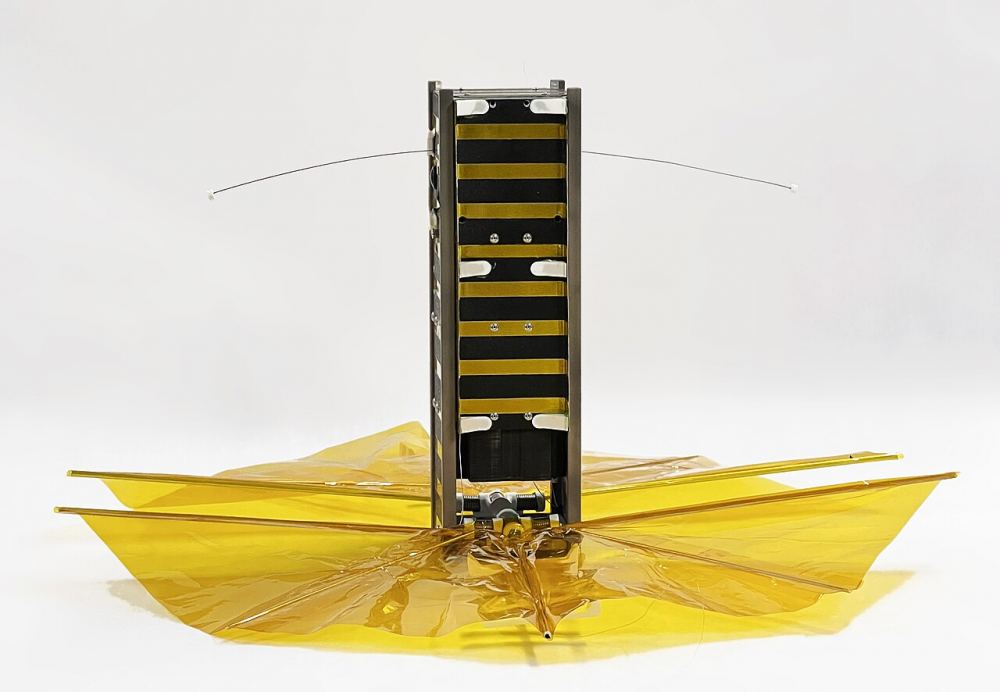In an age of increasing “stuff” orbiting Earth one big concern is what happens if one satellite hits another. The result could be an explosion, or a chain reaction of collisions, or the closure of an orbit. That would be catastrophic. However, a small satellite called SBUDNIC just sent itself back to Earth earlier than expected. It’s goal: to demonstrate a low-cost way to take care of space debris.
SBUDNIC was the brainchild of a group of students at Brown University who were in a “Design of Space Systems” class taught by engineering Professor Rick Fleeter. It was a 3U CubeSat made of off-the-shelf components (including 48 Energizer batteries), a small camera, and a plastic drag sail. It joins a host of other CubeSats used (or proposed for use) at Earth and throughout the Solar System.
The team launched it aboard a SpaceX rocket on May 25, 2022. They communicated with it through a Ham radio-based Arduino prototyping platform. These are commonly used aboard 3U Cubesats due to their light weight and dependability. The idea was to show an affordable deorbit method.

“We were trying to prove that there are ways of deorbiting space junk after mission life has ended that are not super costly,” said Selia Jindal, who graduated from Brown in May and was one of the project leads. “This showed that we can do that. We were successfully able to deorbit our satellite so that it’s no longer taking up space in Earth’s orbit. More importantly, the project really helped show there are significant plans we can put in place to combat the space junk problem that are cost-effective.”
Gradually Leaving Orbit
Once in orbit at an altitude of 520 kilometers, the spacecraft’s sail popped open. Think of its drag sail almost like a drogue chute that slows down the spacecraft. That helped push the tiny spacecraft gradually back into Earth’s atmosphere. It turns out the sail was pretty efficient, which helped the satellite lose altitude. By March of this year, it had slipped to 470 kilometers. Later, on August 8, 2023, it had fallen to 147 kilometers, its last known position. Shortly after that, it burned up over Turkey due to the heat of re-entry.
This is a pretty quick re-entry and demonstrates a useful technology for other satellites. It used to be that these objects could stay in orbit for up to 25 years. But, in 2022, the Federal Communications Commission created a new 5-year rule for deorbiting satellites. It states that spacecraft ending up at altitudes less than kilometers must deorbit as soon as possible and no more than five years after the end of their missions.
One other thing to consider is solar activity. It causes Earth’s atmosphere to “puff up” during periods of solar maximum. That increases the drag on low-orbiting satellites. It’s a known problem that satellite operators face. The low-cost, off-the-shelf technology demonstrated by the Brown student SBUDNIC project offers a useful solution for unanticipated deorbits.
Avoiding Catastrophe through a Classroom Project
The idea of sudden deorbits and other catastrophes in near-Earth space is something that all satellite operators dread. That’s what inspired the student project in the first place. “These are horrible scenarios but unfortunately the numbers dictate probability-wise that this will happen eventually, so we need to be prepared,” said Marco Cross, who graduated from Brown last year with a master’s degree in biomedical engineering and served as chief engineer for SBUDNIC.
Creating the test satellite using a CubeSat as part of a class project provided a perfect chance for engineering students to put theory into practice. The project cost about $10,000 and allowed the students to practice fast “sketch to launch” turnarounds. “This was an unusual circumstance and we took advantage of it,” said Fleeter.
The successful proof of concept was supported by such industry partners as D-Orbit, AMSAT-Italy, as well as La Sapienza-University of Rome, and NASA Rhode Island Space Grant. The results could have a positive impact on efforts to cut down on space debris. “There are companies that are trying to solve this problem of space junk with concepts like space tow trucks or nets in space that will capture space junk and take them out of orbit,” said Dheraj Ganjikunta, who graduated from Brown in 2022 and was SBUDNIC’s lead program manager. “What’s amazing about SBUDNIC is that it’s magnitudes less cost than any of those solutions. Rather than taking junk out of space as it after it becomes a problem, we have this $30 drag device you can just throw onto satellites and radically reduce how long they’re in space.”
For More Information
Satellite Built by Brown Students as Low-cost Way to Reduce Space Junk Reenters Atmosphere Years Early
About SBUDNIC
NASA CubeSat Launch Initiative

